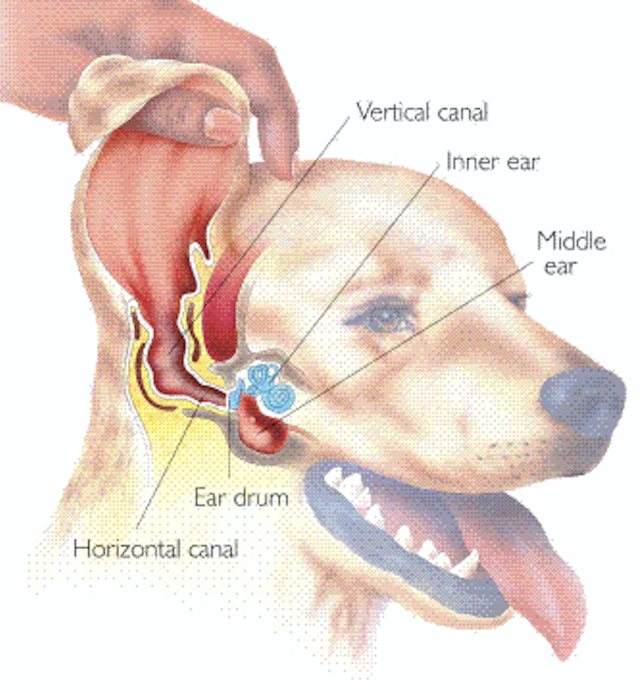Most people have never heard of Idiopathic Vestibular Disease (IVD), also known as “old dog disease” or “old rolling dog syndrome.” It is a sudden, non-progressive disturbance of balance most common in senior dogs.
If you’ve never heard of it or seen it happen, it can be quite frightening, but rest assured, IVD is typically harmless.

What Is Idiopathic Vestibular Disease?
If your senior pet suddenly begins to walk in circles, has an unsteady gait, seems dizzy, or holds its head tilted to one side, Idiopathic Vestibular Disease may be the cause.
The word Idiopathic indicates a condition that comes on spontaneously and has an unknown cause. Vestibular refers to the balance and coordination system within the inner ear of mammals including dogs and humans.
IVD is very frightening for dog parents as its symptoms are similar to those of a stroke or brain tumor. Luckily, IVD is far less serious and usually gets better on its own with time and minimal treatment. It is also painless for your dog.
The Vestibular System
Just like in people, a dog’s vestibular system is responsible for maintaining a sense of balance. When something goes wrong with this system, it’s like being drunk on a rocky boat. Dogs with IVD will have some combination of the following signs:
- A head tilt
- An unsteady gait, loss of balance, or falling over
- Circling in one direction
- Eyes rapidly moving from side to side, known as nystagmus
- Sudden vomiting
If you witness any of these signs, your dog should see a veterinarian for a neurologic and otoscopic examination.
The dog in the following video has a severe case of IVD. Notice the tilted head, unsteady gait, and loss of balance. You can also see her eyes moving rapidly from side to side (nystagmus).
“I think my dog just had a stroke.”
An important thing to note is that these symptoms are not unique. Idiopathic Vestibular Disease and other more serious illnesses often present in similar ways. These include strokes, brain tumors, inner ear infections, inflammatory diseases, and sudden bleeds into the brain.
Dillon’s Story
In early 2019, Tenille Collard of Denver, Colorado came home to find her Husky, Dillon unable to walk or stand. At first, she attributed the problem to the dog’s glaucoma. He had already lost his right eye to the condition, and the veterinary ophthalmologist warned there was a chance the other eye could become affected.
When she gave Dillon his emergency eye drops, Collard noticed his eyes moving rapidly back and forth. The symptom, known as nystagmus, is often associated with strokes. Shocked by the sudden symptoms, Collard and Dillon headed to the emergency vet.
Thankfully, a neurological exam revealed Dillon did not suffer a stroke. Instead, he was diagnosed with vestibular disease. Medications for nausea and motion sickness helped him slowly improve over the next few days, and a complete blood panel at his follow-up visit ruled out an underlying condition.
With time and supportive care, Dillon made a near-full recovery. Like many dogs with IVD, his head still tilts to one side and he is sometimes unstable when walking.

Diagnosing IVD
Veterinarians typically recommend blood work and a blood pressure check for dogs showing vestibular signs. MRIs can also be done to evaluate the inner ear and brain. This allows for the best evaluation of disease but is often not pursued due to cost.
Evaluation should include both ear canals since inner ear infections are a possible cause of vestibular disease. The inner ear (pictured below) is something you cannot directly see during an exam because the eardrum covers the view. However, if there is inflammation in the outer ear and eardrum, there is a good chance inner ear disease is present as well.

Caring For A Dog With Vestibular Disease
If clinical signs are so severe that the dog cannot walk, your vet may recommend supportive care with IV fluids and anti-nausea medications. If clinical signs are mild, pets can often be managed at home with nursing care and over-the-counter meds for motion sickness.
Dillon’s mom recommends the Help Em Up Harness which proved to be a lifesaver in helping get the large dog outside during the worst of his dizziness.
What Is The Long-Term Prognosis For Dogs With IVD?
Idiopathic Vestibular Disease has a very loose rule of thumb: If there is gradual or complete improvement within 72 hours, it is most likely IVD. If there is no improvement or if there is a progression of symptoms, the cause could be something more serious, such as a brain tumor. In this case, an MRI is recommended.
With idiopathic vestibular disease, slow but steady improvement and a return to normal (or almost normal) is typically seen in 7 to 14 days. For some dogs, a head tilt will persist for the rest of their lives.
 Toledo, United States.
Toledo, United States.